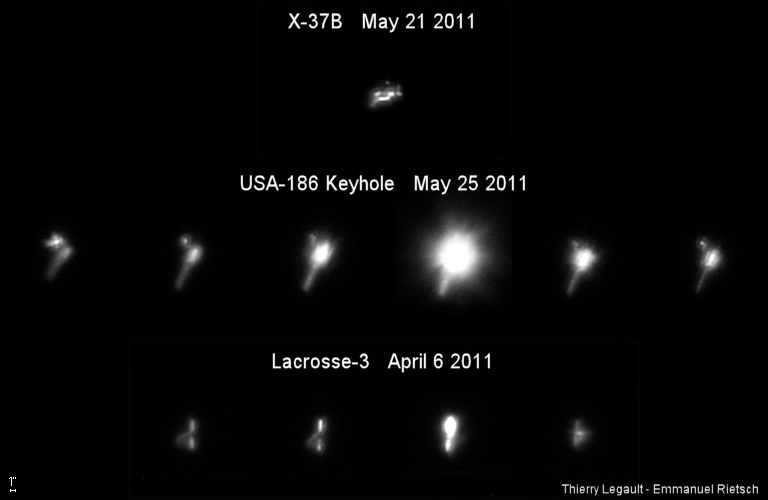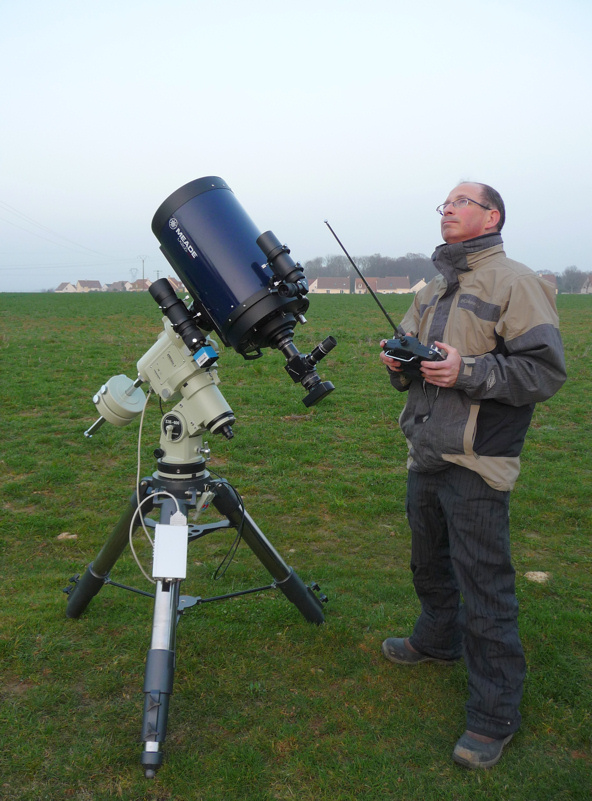Thierry Legault is not your average amateur astronomer, inviting the kids over and pointing a dinky backyard telescope at the Big Dipper. He’s a renowned astrophotographer, painstakingly chronicling the orbits of planets, distant galaxies, spaceships, and—to the chagrin of the intelligence community—of the spy satellites we’re not supposed to see.These days, we are inundated with a constant feed of reality defying images sent back to us from space by the very carefully calibrated equipment we send up there. But for Thierry, the act of capturing space is a much more personal process. It’s man versus nature.And upon our rainy arrival at Charles de Gaulle Airport, there she was. As we looked up on the cold and rainy Friday of our arrival in Paris, looking forward to a fantastic voyage of space, the sky thundered its response.In order to capture a planetary passing, a satellite, or a shuttle, Thierry often travels thousands of miles to the far reaches of the Earth, often in a race with time and weather, and he often fails. “It is not funnest part of the game, driving, and trying to find clear skies, but when it is successful, it is more rewarding,” Theirry says.Ultimately, weather and timing matter, but so does technology. The very logistics of capturing these fleeting moments themselves tend to involve complex calculations and the help of sophisticated camera and telescope tracking technologies. He often doesn’t actually see the moments in space he photographs because he’s looking at his watch.He is of course not alone in his quest to photograph our universe. We met up with him at the Meeting of Sky and Space at the Cité des Sciences et de l’Industrie Congress, a massive event that takes place every two years to address how we look at space. Thierry was there to deliver a keynote lecture on the science and future of satellite-tracking and amateur astronomy. In the past decades, the field has revolutionized by digital equipment that can, for instance, help him follow tiny spy satellites as they zip across the sky, or simply help discover camera or telescope problems in real time.“With a film camera the main disadvantage was you didn’t have the result immediately, but the day after or the week after,” he said. “So now with a digital camera, which is much more sensitive than film, we have the results right now so if the image is blurred or under exposed or over exposed or any kind of problem, we can correct the problem immediately. And so the learning curve for a beginner is much, much faster than before.”Thierry’s work has appeared in the Guardian, CNN and Popular Science, and seen around the world. His name is synonymous with astrophotography, and he has the distinction of being the first person in the world to spot the Air Force’s miniature space shuttle, the X-37B, during its secret missions, apparently over Afghanistan, in 2011.The spy organizations of the world—led by the US, which has more satellites in space than any nation—carefully guard the orbits of their classified spacecraft, machines that may be capable of seeing objects as small as perhaps 10 cm (4 inches) across on Earth. That makes Thierry and other amateur satellite-trackers around the planet a tiny thorn in the side of their intelligence effort. Still, he’s not very worried about becoming the subject of a clandestine satellite’s camera. “We know their trajectory, their orbital data, and we take images with some details,” he said. “But we can’t discover really the capabilities of these satellites. So it’s more like a game,” he said with a laugh, “spying spy satellites.”Still the passion that Thierry throws into his masterful combination of science and art transcends the technicalities of space and politics. “I photograph satellites because it’s difficult, it’s kind of a challenge with myself. Each time I say ‘can you succeed or not?’ and ‘next time, can you do better? Can you do another satellite, something else, something more difficult?’ So it’s a way to improve my skill with a telescope. It’s like a game or a challenge.”
“We know their trajectory, their orbital data, and we take images with some details,” he said. “But we can’t discover really the capabilities of these satellites. So it’s more like a game,” he said with a laugh, “spying spy satellites.”Still the passion that Thierry throws into his masterful combination of science and art transcends the technicalities of space and politics. “I photograph satellites because it’s difficult, it’s kind of a challenge with myself. Each time I say ‘can you succeed or not?’ and ‘next time, can you do better? Can you do another satellite, something else, something more difficult?’ So it’s a way to improve my skill with a telescope. It’s like a game or a challenge.” He savors the philosophical questions too, wondering as he looks up who else—besides the CIA—is looking back down. “When you look at a galaxy and you know that this galaxy is composed of hundreds of billions of stars and around all these stars, like the sun, there are many planets, and perhaps someone, who knows, who is watching us.”In an age where our images of space come from images and reconstituted data streamed from machines launched by large corporations and NASA-sized organizations—and a future of spaceplanes and entrepreneurs promises to open space to everyone—Thierry Legault remains a lone wolf, a star hunter and satellite tracker who relies on his own methods for making fantastic voyages way beyond Earth.
He savors the philosophical questions too, wondering as he looks up who else—besides the CIA—is looking back down. “When you look at a galaxy and you know that this galaxy is composed of hundreds of billions of stars and around all these stars, like the sun, there are many planets, and perhaps someone, who knows, who is watching us.”In an age where our images of space come from images and reconstituted data streamed from machines launched by large corporations and NASA-sized organizations—and a future of spaceplanes and entrepreneurs promises to open space to everyone—Thierry Legault remains a lone wolf, a star hunter and satellite tracker who relies on his own methods for making fantastic voyages way beyond Earth.
Advertisement
International Space Station transiting the sun
Veil Nebula, NGC 6992
A close-up on Omega Centauri, with numerous very small galaxies.
Advertisement

Ground-based images of three different classified US satellites: the X-37B mini space shuttle, the USA-186 Keyhole, and the LaCrosse 3. (Credit: Thierry Legault and Emmanuel Rietsch).
Advertisement

